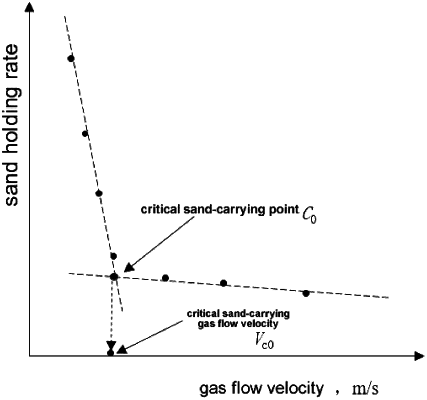| CPC G01V 11/002 (2013.01) | 1 Claim |

|
1. A method for experimentally determining a critical sand-carrying gas velocity of a shale gas well, comprising:
Step S1: collecting well structure data of the shale gas well and production data of the shale gas well over its entire life cycle, and calculating parameter ranges of a gas flow velocity and a liquid flow velocity under an experimental condition by means of a fluid mechanics similarity criterion, wherein an oil pipe inner diameter, sand flow rate, sand grain diameter, sand density and well inclination angle are consistent with parameters of the shale gas well;
Step S2: carrying out a physical simulation experiment of sand carrying in the shale gas well, and obtaining sand holding amounts of a wellbore under different conditions of gas flow velocity, liquid flow velocity, oil pipe inner diameter, sand flow rate, sand grain diameter, sand density and well inclination angle within experimental parameter ranges, and calculating a sand holding rate; ensuring accuracy of the experiment by starting to measure the sand holding amount of the wellbore after sand comes out of the wellhead uniformly and stably for three minutes under a condition that the gas flow velocity, the liquid flow velocity and the sand flow rate are stable at target parameters, and repeating the experiment three times to take an average value of the sand holding amounts, wherein the sand is dried before weighing, in order to avoid water attached to outer surfaces of the sand affecting the sand holding amounts;
Step S3: determining the critical sand-carrying gas velocity under different experimental conditions, and using the sand holding rate of the wellbore to characterize a sand carrying capacity of the gas well, wherein a small sand holding rate of the wellbore indicates that the sand occupies a small area of production channel of the gas well and the gas well is capable of producing stably, while a large sand holding rate affects stable production of the gas well; by observing a change curve of the sand holding rate of the wellbore vs. the gas flow velocity, defining a turning point at which the sand holding rate of the wellbore increases as the critical sand-carrying gas velocity, and analyzing an influence of each experimental variable on the turning point, to obtain the critical sand-carrying gas velocity under different experimental conditions;
and, in a coordinate system of the sand holding rate vs. the gas flow velocity wherein the change curve of the sand holding rate vs. the gas flow velocity has an obvious turning point, defining parts of the curve before and after the turning point as a low gas flow velocity curve and a high gas flow velocity curve, respectively, taking 5 data from ends of the two curves respectively, and using least squares to linearly fit straight lines; due to different slopes of two straight lines, finding an intersection point of linear-fitted straight lines of low gas flow velocity and high gas flow velocity, wherein the intersection point is the critical sand-carrying gas velocity corresponding to the gas flow velocity; changing the liquid flow velocity and obtain the change curve of the sand holding rate vs. the gas flow velocity under different liquid flow velocities, using the same method to determine the critical sand-carrying gas velocity under different liquid flow velocities; and changing the experimental variables of oil pipe inner diameter, sand flow rate, sand grain diameter, sand density and well inclination angle, to obtain the critical sand-carrying gas velocity under different experimental conditions;
Step S4: determining the sand carrying capacity of the shale gas well, wherein the Step S1 is used to determine the gas flow velocity and the liquid flow velocity of the shale gas well in production under experimental conditions, and Step S3 is used to determine a critical sand-carrying gas flow velocity under the same experimental condition of liquid flow velocity, oil pipe inner diameter, sand grain diameter, sand density and well inclination angle, compare the gas flow velocity of the shale gas well under the experimental condition with the corresponding critical sand-carrying gas flow velocity, wherein when the gas flow velocity of the shale gas well under the experimental condition is not less than the critical sand-carrying gas flow velocity, it indicates that the well is capable of continuing to produce stably; when the gas flow velocity of the shale gas well under the experimental condition is less than the critical sand-carrying gas flow velocity, it indicates that sand production of the well affects normal production of the gas well.
|